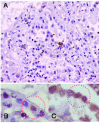Influenza A H5N1 replication sites in humans
- PMID: 16022777
- PMCID: PMC3371815
- DOI: 10.3201/eid1107.041313
Influenza A H5N1 replication sites in humans
Abstract
Tissue tropism and pathogenesis of influenza A virus subtype H5N1 disease in humans is not well defined. In mammalian experimental models, H5N1 influenza is a disseminated disease. However, limited previous data from human autopsies have not shown evidence of virus dissemination beyond the lung. We investigated a patient with fatal H5N1 influenza. Viral RNA was detected by reverse transcription-polymerase chain reaction in lung, intestine, and spleen tissues, but positive-stranded viral RNA indicating virus replication was confined to the lung and intestine. Viral antigen was detected in pneumocytes by immunohistochemical tests. Tumor necrosis factor-? mRNA was seen in lung tissue. In contrast to disseminated infection documented in other mammals and birds, H5N1 viral replication in humans may be restricted to the lung and intestine, and the major site of H5N1 viral replication in the lung is the pneumocyte.
Figures



Similar articles
-
Viral load of the highly pathogenic avian influenza H5N1 virus in infected human tissues.J Med Virol. 2011 Aug;83(8):1418-23. doi: 10.1002/jmv.22146. J Med Virol. 2011. PMID: 21678447
-
Pathological lesions and viral localization of influenza A (H5N1) virus in experimentally infected Chinese rhesus macaques: implications for pathogenesis and viral transmission.Arch Virol. 2009;154(2):227-33. doi: 10.1007/s00705-008-0277-5. Epub 2009 Jan 8. Arch Virol. 2009. PMID: 19130169
-
Localization of pandemic 2009 H1N1 influenza A virus RNA in lung and lymph nodes of fatal influenza cases by in situ hybridization: new insights on virus replication and pathogenesis.J Clin Virol. 2013 Mar;56(3):232-7. doi: 10.1016/j.jcv.2012.11.014. Epub 2012 Dec 14. J Clin Virol. 2013. PMID: 23246358
-
Avian influenza A (H5N1) infection in humans.N Engl J Med. 2005 Sep 29;353(13):1374-85. doi: 10.1056/NEJMra052211. N Engl J Med. 2005. PMID: 16192482 Review. No abstract available.
-
Pathology, molecular biology, and pathogenesis of avian influenza A (H5N1) infection in humans.Am J Pathol. 2008 May;172(5):1155-70. doi: 10.2353/ajpath.2008.070791. Epub 2008 Apr 10. Am J Pathol. 2008. PMID: 18403604 Free PMC article. Review.
Cited by
-
Avian influenza A (H5N1).J Clin Virol. 2006 Jan;35(1):2-13. doi: 10.1016/j.jcv.2005.09.002. Epub 2005 Oct 6. J Clin Virol. 2006. PMID: 16213784 Free PMC article. Review.
-
Crossing barriers: infections of the lung and the gut.Mucosal Immunol. 2009 Mar;2(2):100-2. doi: 10.1038/mi.2008.79. Epub 2008 Dec 24. Mucosal Immunol. 2009. PMID: 19129753 Free PMC article.
-
Pathological study of archival lung tissues from five fatal cases of avian H5N1 influenza in Vietnam.Mod Pathol. 2013 Mar;26(3):357-69. doi: 10.1038/modpathol.2012.193. Epub 2012 Nov 23. Mod Pathol. 2013. PMID: 23174938 Free PMC article.
-
Host Receptors of Influenza Viruses and Coronaviruses-Molecular Mechanisms of Recognition.Vaccines (Basel). 2020 Oct 6;8(4):587. doi: 10.3390/vaccines8040587. Vaccines (Basel). 2020. PMID: 33036202 Free PMC article. Review.
-
H5N1 infection of the respiratory tract and beyond: a molecular pathology study.Lancet. 2007 Sep 29;370(9593):1137-45. doi: 10.1016/S0140-6736(07)61515-3. Lancet. 2007. PMID: 17905166 Free PMC article.
References
Publication types
MeSH terms
LinkOut - more resources
Full Text Sources
Other Literature Sources
Medical
